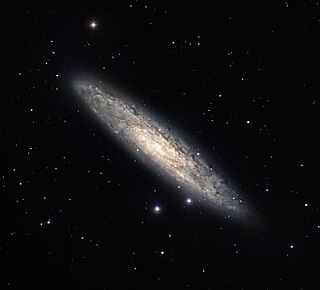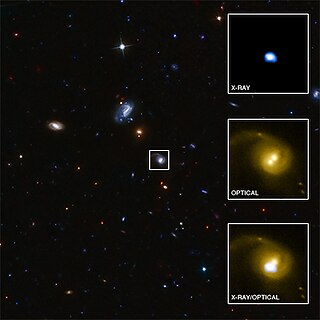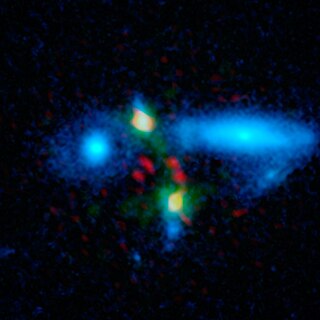
A galaxy is a system of stars, stellar remnants, interstellar gas, dust, and dark matter bound together by gravity. The word is derived from the Greek galaxias (γαλαξίας), literally 'milky', a reference to the Milky Way galaxy that contains the Solar System. Galaxies, averaging an estimated 100 million stars, range in size from dwarfs with less than a thousand stars, to the largest galaxies known – supergiants with one hundred trillion stars, each orbiting its galaxy's center of mass. Most of the mass in a typical galaxy is in the form of dark matter, with only a few percent of that mass visible in the form of stars and nebulae. Supermassive black holes are a common feature at the centres of galaxies.

An Einstein ring, also known as an Einstein–Chwolson ring or Chwolson ring, is created when light from a galaxy or star passes by a massive object en route to the Earth. Due to gravitational lensing, the light is diverted, making it seem to come from different places. If source, lens, and observer are all in perfect alignment (syzygy), the light appears as a ring.

The Sculptor Galaxy is an intermediate spiral galaxy in the constellation Sculptor. The Sculptor Galaxy is a starburst galaxy, which means that it is currently undergoing a period of intense star formation.

The South Pole Telescope (SPT) is a 10-metre (390 in) diameter telescope located at the Amundsen–Scott South Pole Station, Antarctica. The telescope is designed for observations in the microwave, millimeter-wave, and submillimeter-wave regions of the electromagnetic spectrum, with the particular design goal of measuring the faint, diffuse emission from the cosmic microwave background (CMB). The first major survey with the SPT—designed to find distant, massive, clusters of galaxies through their interaction with the CMB, with the goal of constraining the dark energy equation of state—was completed in October 2011. In early 2012, a new camera (SPTpol) was installed on the SPT with even greater sensitivity and the capability to measure the polarization of incoming light. This camera operated from 2012–2016 and was used to make unprecedentedly deep high-resolution maps of hundreds of square degrees of the Southern sky. In 2017, the third-generation camera SPT-3G was installed on the telescope, providing nearly an order-of-magnitude increase in mapping speed over SPTpol.
Luminous infrared galaxies or LIRGs are galaxies with luminosities, the measurement of brightness, above 1011 L☉. They are also referred to as submillimeter galaxies (SMGs) through their normal method of detection. LIRGs are more abundant than starburst galaxies, Seyfert galaxies and quasi-stellar objects at comparable luminosity. Infrared galaxies emit more energy in the infrared than at all other wavelengths combined. A LIRG's luminosity is 100 billion times that of the Sun.

APM 08279+5255 is a very distant, broad absorption line quasar located in the constellation Lynx. It is magnified and split into multiple images by the gravitational lensing effect of a foreground galaxy through which its light passes. It appears to be a giant elliptical galaxy with a supermassive black hole and associated accretion disk. It possesses large regions of hot dust and molecular gas, as well as regions with starburst activity.
The Cloverleaf quasar is a bright, gravitationally lensed quasar.

In cosmology, primordial black holes (PBHs) are hypothetical black holes that formed soon after the Big Bang. In the inflationary era and early radiation-dominated universe, extremely dense pockets of subatomic matter may have been tightly packed to the point of gravitational collapse, creating primordial black holes without the supernova compression typically needed to make black holes today. Because the creation of primordial black holes would pre-date the first stars, they are not limited to the narrow mass range of stellar black holes.

CID-42 is a galaxy quasar about 3.9 billion light years away in the constellation Sextans. It is believed to have a supermassive black hole at its center.

MACS0647-JD is a galaxy with a redshift of about z = 10.7, equivalent to a light travel distance of 13.26 billion light-years. If the distance estimate is correct, it formed about 427 million years after the Big Bang.

HXMM01, known more formally as 1HERMES S250 J022016.5−060143, is a starburst galaxy located in the northwestern portion of the constellation Cetus. Discovered in 2013 by a team at the University of California, Irvine, it was discovered that HXMM01 is actually still forming from its two parent galaxies as part of the "brightest, most luminous and most gas-rich submillimeter-bright galaxy merger known." When the merger is complete, HXMM01 will rapidly evolve to become a giant elliptical galaxy with a mass about four times that of the Milky Way. As of 2013, HXMM01 has been observed to form about 2,000 M☉ of stars every year, with an efficiency ten times greater than that of typical galaxies and far more than the Milky Way's 0.68–1.45 M☉ per year.
HFLS3 is the name for a distant galaxy at z = 6.34, originating about 880 million years after the Big Bang. Its discovery was announced on 18 April 2013 as an exceptional starburst galaxy producing nearly 3,000 solar masses of stars a year. It was found using the far-infrared-capable Herschel Space Telescope. The galaxy was estimated to have 35 billion stars. It is 10–30 times the mass of other known galaxies at such an early time in the universe.

ASW0009io9 (9io9) is a gravitationally lensed system of two galaxies. The nearer galaxy is approximately 2 billion light-years (610 Mpc) from Earth and is designated SDSS J020941.27+001558.4, while the lensed galaxy is 10 billion light-years (3.1 Gpc) distant and is designated ASW0009io9. It was discovered in January 2014 by a group of citizen scientists, while classifying images on the website Spacewarps.org. The discovery was announced on the BBC television programme Stargazing Live.

HIP 65426 b, formally named Najsakopajk, is a super-Jupiter exoplanet orbiting the star HIP 65426. It was discovered on 6 July 2017 by the SPHERE consortium using the Spectro-Polarimetric High-Contrast Exoplanet Research (SPHERE) instrument belonging to the European Southern Observatory (ESO). It is 385 light-years from Earth. It is the first planet discovered by ESO's SPHERE instrument.

Webb's First Deep Field is the first operational image taken by the James Webb Space Telescope (JWST). The deep-field photograph, which covers a tiny area of sky visible from the Southern Hemisphere, is centered on SMACS 0723, a galaxy cluster in the constellation of Volans. Thousands of galaxies are visible in the image, some as old as 13 billion years. It is the highest-resolution image of the early universe ever taken. Captured by the telescope's Near-Infrared Camera (NIRCam), the image was revealed to the public by NASA on 11 July 2022.

SMACS J0723.3–7327, commonly referred to as SMACS 0723, is a galaxy cluster about 4 billion light years from Earth, within the southern constellation of Volans. It is a patch of sky visible from the Southern Hemisphere on Earth and often observed by the Hubble Space Telescope and other telescopes in search of the deep past. It was the target of the first full-color image to be unveiled by the James Webb Space Telescope (JWST), imaged using NIRCam, with spectra included, showing objects lensed by the cluster with redshifts implying they are 13.1 billion years old. The cluster has been previously observed by the Hubble Space Telescope (HST) as part of the Southern MAssive Cluster Survey (SMACS), as well as Planck and Chandra.

GLASS-z12 is a Lyman-break galaxy discovered by the Grism Lens-Amplified Survey from Space (GLASS) observing program using the James Webb Space Telescope's NIRCam in July 2022. Spectroscopic observations of GLASS-z12 by the Atacama Large Millimeter Array (ALMA) in August 2022 confirmed that the galaxy has a spectroscopic redshift of 12.117±0.012, making it one of the earliest and most distant galaxies ever discovered, dating back to just 350 million years after the Big Bang, 13.6 billion years ago. ALMA observations detected an emission line associated with doubly ionized oxygen at 258.7 GHz with a significance of 5σ, suggesting that there is very low dust content in GLASS-z12, if not the early universe as well. Also based on oxygen-related measurements, the age of the galaxy is confirmed.
Caitlin M Casey is an observational astronomer and associate professor at the University of Texas at Austin. She is known for her work in extragalactic astrophysics where she works on the formation and evolution of galaxies.

UNCOVER-z13 is a high-redshift Lyman-break galaxy discovered by the James Webb Space Telescope (JWST) during NIRCam imaging for the JWST Ultradeep NIRSpec and NIRCam Observations before the Epoch of Reionization (UNCOVER) project on November 14, 2023. UNCOVER-z13 is within Abell 2744 supercluster in the constellation Sculptor.













